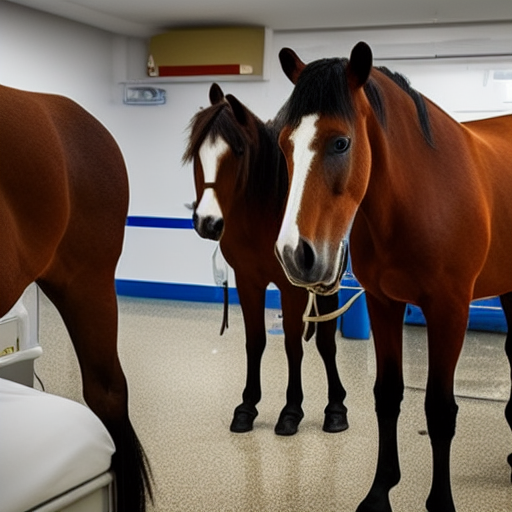Penicillin in Horses; Impeccable Guide in 10 minutes
Since Penicillin’s discovery in 1928 by Alexander Fleming, this antibiotic has become one of the most commonly prescribed medications in the world. It’s used to treat a wide variety of bacterial and viral infections. Penicillin in Horses treats strangles, infective laryngitis, pneumonia, cellulitis, and wound infection. Treatment with this medication is relatively simple; however, there are some essential things to keep in mind to ensure successful treatment. This article will provide an overview of the use of Penicillin in horses, as well as dosage and administration tips.
Penicillins, also called penams, occur naturally and possess a bicyclic skeleton: a β-lactam ring fused with a thiazolidine ring (4-thia-1-azabicyclo[3.2. 0]heptan-7-one in IUPAC nomenclature)
Molecular Formula C16H18N2O4S
Molecular Weight 334.4 g/mol
Storage Store in a refrigerator, 2° to 8°C (36° to 46°F). Keep from freezing.
Penicillin Class Penicillin is a medication used to manage and treat many infections. It is in the beta-lactam antibiotic class of drugs
Penicillin Composition The basic chemical structure of all penicillins consists of a beta-lactam ring, a thiazolidine ring, and a side chain (6- aminopenicillanic acid).

Have you ever used Penicillin on horses?
Penicillin is a very commonly used antibiotic to treat bacterial infections in horses. It works by preventing bacteria from growing and multiplying. It can inject intramuscularly or subcutaneously, as well as it can also be used orally. The dosage and frequency of penicillin administration will vary depending on the horse’s age, weight, and health condition.
In most cases, Penicillin is safe and effective for treating bacterial infections in horses. These side effects include allergic reactions, gastrointestinal upset, and colic. Penicillin is used under the guidance of a veterinarian.

What are your thoughts on the efficacy of Penicillin in horses?
Penicillin in horses works by preventing bacteria from growing and multiplying. It is generally effective against many bacteria, including Streptococcus, Staphylococcus, and Haemophilus influenza. Penicillin is usually well tolerated by horses, with the most common side effect being mild gastrointestinal upset. Do not use it in horses known to be allergic to it. Penicillin is an essential medication for treating bacterial infections in horses, and it is generally safe and effective when used as directed.
What do you think are the benefits of using Penicillin in horses?
- Penicillin is an antibiotic to treat bacterial infections in horses.
- It works by killing the bacteria that cause the disease.
- Penicillin is effective against a wide range of bacteria, including those that cause pneumonia, septicemia, and strangles.
- It is also commonly used to prevent infections in injured or ill horses.
- Penicillin can be given orally or intramuscularly and is typically well-tolerated by horses.

Are there any side effects to using Penicillin in horses?
- Penicillin is a medication that treats bacterial infections in horses.
- It works by preventing the bacteria from growing and spreading.
- Penicillin is generally safe and well-tolerated, but there are a few potential side effects.
- These include allergic reactions, gastrointestinal upset, and kidney damage.
- Allergic reactions are the most serious and can be life-threatening.
- If your horse has any history of allergies, Penicillin should use with caution.
- Gastrointestinal upset is another common side effect and can cause diarrhea, colic, and vomiting.
- In rare cases, Penicillin can also cause kidney damage.
If you notice these side effects after giving your horse penicillin, contact your veterinarian immediately.

Dosage of Penicillin in Horses?
Penicillin is a common antibiotic that is involved in treating a variety of bacterial infections in horses. The standard dosage of Penicillin for horses is 10,000 units per pound of body weight given once daily by intramuscular injection. For most horses, this is equivalent to approximately 1 gram (1000 mg) of Penicillin per day.
The dose may be increased to twice daily if necessary. Penicillin should be administered for at least 3-5 days, preferably for 7-10 days. Another antibiotic should be used if the infection does not respond to Penicillin.
Both horses tolerate Penicillin, but some may experience gastrointestinal upset or allergic reactions. Penicillin should be used cautiously in horses with known allergies or sensitivities, as with any medication.
Conclusion
Penicillin is a well-known and trusted antibiotic for horses that is effective against many different types of bacteria. It can be given orally or intramuscularly, making it a versatile treatment option. Horses tolerate penicillin very well, making it a safe choice for treating bacterial infections.





Thank you for posting
Top site ,.. amazaing post ! Just keep the work on !
Hm,.. amazing post ,.. just keep the good work on!